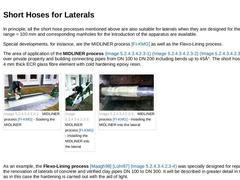
|
In principle, all the short hose processes mentioned above are also suitable for laterals when they are designed for the nominal size range = 100 mm and corresponding manholes for the introduction of the apparatus are available. Special developments, for instance, are the MIDLINER process [FI-KMG] as well as the Flexo-Lining process. The area of application of the MIDLINER process (Bild 5.2.3.2.3.1.2) (Bild 5.2.3.2.3.1.2) (Bild 5.2.3.2.3.1.2) ranges … |
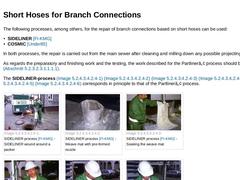
|
The following processes, among others, for the repair of branch connections based on short hoses can be used: -
SIDELINER [FI-KMG]
-
COSMIC [Under85]
In both processes, the repair is carried out from the main sewer after cleaning and milling down any possible projecting nozzle parts. As regards the preparatory and finishing work and the testing, the work described for the Partlinerâ„¢ process should be carried out (Abschnitt 5.2.3.2.3.1.1.1.1). The SIDELINER-… |
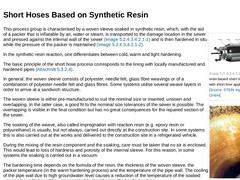
|
|
(Image: Synthetic resin-based short liner - Packer with short liner applied over it)
|
|
(Image: Synthectic resin based short hose - View on installed short hose (3P-Liner) [FI-Jtele])
|
This process group is characterised by a woven sleeve soaked in synthetic resin, which, with the aid of a packer that is inflatable by air, water or steam, is transported to the damage location in the sewer and pressed against the internal wall of the sewer (Bild 5.2.3.2.3.1) |

|
One representative of the short hose process based on cement as a binder is the ERGELIT shortliner process. According to the manufacturer, it can be used in circular cross sections DN 150 to DN 600 for the repair of cracks and smaller pipe breaks [FI-Herme]. Pre-mixed dry grout type ERGELIT Kombina KT is applied in a thickness of approx. 2 mm and a length up to 60 cm max. onto a packer. Then ERGELIT strip is dipped about 2 min. into water. After allowing … |
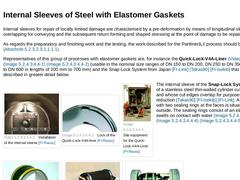
|
Internal sleeves for repair of locally limited damage are characterised by a pre-deformation by means of longitudinal slots and overlapping for conveying and the subsequent return forming and shaped stressing at the point of damage to be repaired. As regards the preparatory and finishing work and the testing, the work described for the Partlinerâ„¢ process should be carried out (Abschnitt 5.2.3.2.3.1.1.1.1). Representatives of this group of processes … |
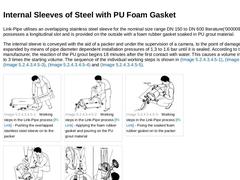
|
Link-Pipe utilises an overlapping stainless steel sleeve for the nominal size range DN 150 to DN 600 literature('0000094057'), which possesses a longitudinal slot and is provided on the outside with a foam rubber gasket soaked in PU grout material. The internal sleeve is conveyed with the aid of a packer and under the supervision of a camera, to the point of damage and is there expanded by means of pipe diameter dependent installation pressures of … |
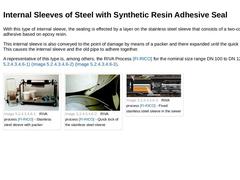
|
With this type of internal sleeve, the sealing is effected by a layer on the stainless steel sleeve that consists of a two-component adhesive based on epoxy resin. This internal sleeve is also conveyed to the point of damage by means of a packer and there expanded until the quick seal clicks in. This causes the internal sleeve and the old pipe to adhere together. A representative of this type is, among others, the RIVA Process [FI-RICO] for the nominal … |
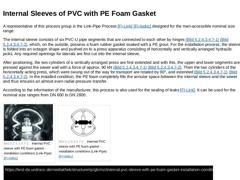
|
A representative of this process group is the Link-Pipe Process [FI-Link] [FI-Isekic] designed for the man-accessible nominal size range.
The internal sleeve consists of six PVC-U pipe segments that are connected to each other by hinges (Bild 5.2.3.2.3.6) (Bild 5.2.3.2.3.6), which, on the outside, possess a foam rubber gasket soaked with a PE grout. For the installation process, the sleeve is folded into an octagon shape and pushed on to a press … |

|
This process is used exclusively in man-accessible sewers or manholes. After a careful cleaning of the pipe walling on both sides of the leaking position, an elastomer sealing sleeve is applied by hand over the region to be sealed and is pressed against the pipe wall surfaces by means of bracing strips (Bild 5.2.3.2.3.7.1) (Bild 5.2.3.2.3.7.1) (Bild 5.2.3.2.3.7.1) (Bild 5.2.3.2.3.7.1) (Bild 5.2.3.2.3.7.1). Both the Weco-Seal process [FI-Wegne] and … |
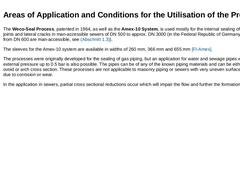
|
The Weco-Seal Process, patented in 1964, as well as the Amex-10 System, is used mostly for the internal sealing of leaking pipe joints and lateral cracks in man-accessible sewers of DN 500 to approx. DN 3000 (in the Federal Republic of Germany, only pipes from DN 600 are man-accessible, see Abschnitt 1.3). The sleeves for the Amex-10 system are available in widths of 260 mm, 366 mm and 655 mm [FI-Amex]. The processes were originally developed for the … |
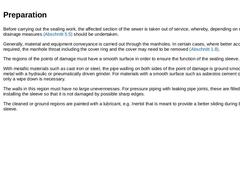
|
Before carrying out the sealing work, the affected section of the sewer is taken out of service, whereby, depending on requirements, drainage measures (Abschnitt 5.5) should be undertaken. Generally, material and equipment conveyance is carried out through the manholes. In certain cases, where better access may be required, the manhole throat including the cover ring and the cover may need to be removed (Abschnitt 1.8). The regions of the points of … |
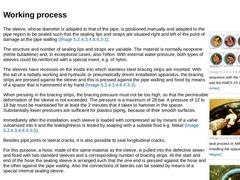
|
|
(Image: Working sequence with the Weco process and the AMEX-10 system [FI-Amex])
|
|
(Image: Weco seal process or AMEX-10 system - Installing the spacer pieces [FI-Wegne])
|
|
(Image: Leaktighness testing of the sleeve [FI-Wegne])
|
The sleeve, whose diameter is adapted to that of the pipe, is positioned manually and adapted to the pipe region to be sealed such that the sealing lips and straps are situated right and left of the point of damage at the … |

|
After completion of the sealing works, the section of the sewer is cleaned out and, if necessary the manhole is rebuilt and the pipe is taken into use again. |
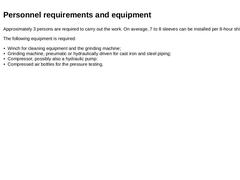
|
Approximately 3 persons are required to carry out the work. On average, 7 to 8 sleeves can be installed per 8-hour shift. The following equipment is required: - Winch for cleaning equipment and the grinding machine;
- Grinding machine, pneumatic or hydraulically driven for cast iron and steel piping;
- Compressor, possibly also a hydraulic pump:
- Compressed air bottles for the pressure testing.
|
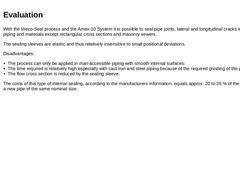
|
With the Weco-Seal process and the Amex-10 System it is possible to seal pipe joints, lateral and longitudinal cracks in all types of piping and materials except rectangular cross sections and masonry sewers. The sealing sleeves are elastic and thus relatively insensitive to small positional deviations. Disadvantages: - The process can only be applied in man-accessible piping with smooth internal surfaces;
- The time required is relatively high especially …
|

|
|
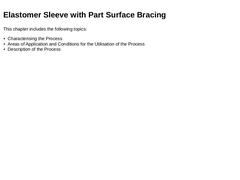
|
|
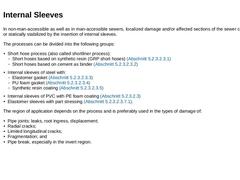
|
In non-man-accessible as well as in man-accessible sewers, localized damage and/or affected sections of the sewer can be sealed or statically stabilized by the insertion of internal sleeves. The processes can be divided into the following groups: - Short hose process (also called shortliner process):
- Short hoses based on synthetic resin (GRP short hoses) (Abschnitt 5.2.3.2.3.1)
- Short hoses based on cement as binder (Abschnitt 5.2.3.2.3.2)
- Internal sleeves …
|

|
|
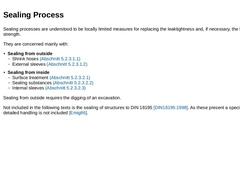
|
Sealing processes are understood to be locally limited measures for replacing the leaktightness and, if necessary, the bearing strength. They are concerned mainly with: - Sealing from outside
- Shrink hoses (Abschnitt 5.2.3.1.1)
- External sleeves (Abschnitt 5.2.3.1.2)
- Sealing from inside
- Surface treatment (Abschnitt 5.2.3.2.1)
- Sealing substances (Abschnitt 5.2.3.2.2)
- Internal sleeves (Abschnitt 5.2.3.2.3)
Sealing from outside requires the digging of an … |
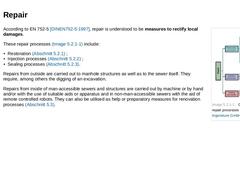
|
(Image: Overview of the repair processes) According to EN 752-5 [DINEN752-5:1997], repair is understood to be measures to rectify local damages. These repair processes (Bild 5.2) include: - Restoration (Abschnitt 5.2.1) ;
- Injection processes (Abschnitt 5.2.2) ;
- Sealing processes (Abschnitt 5.2.3).
Repairs from outside are carried out to manhole structures as well as to the sewer itself. They require, among others the digging of an excavation. Repairs from … |
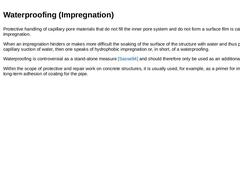
|
Protective handling of capillary pore materials that do not fill the inner pore system and do not form a surface film is called impregnation. When an impregnation hinders or makes more difficult the soaking of the surface of the structure with water and thus prevents the capillary suction of water, then one speaks of hydrophobic impregnation or, in short, of a waterproofing. Waterproofing is controversial as a stand-alone measure [Sasse94] and should … |
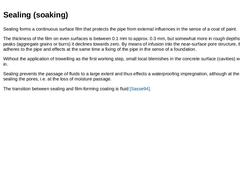
|
Sealing forms a continuous surface film that protects the pipe from external influences in the sense of a coat of paint. The thickness of the film on even surfaces is between 0.1 mm to approx. 0.3 mm, but somewhat more in rough depths. On rough peaks (aggregate grains or burrs) it declines towards zero. By means of infusion into the near-surface pore structure, this film adheres to the pipe and effects at the same time a fixing of the pipe in the … |
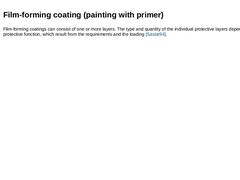
|
Film-forming coatings can consist of one or more layers. The type and quantity of the individual protective layers depends on the protective function, which result from the requirements and the loading [Sasse94]. |
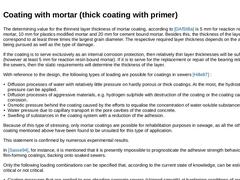
|
The determining value for the thinnest layer thickness of mortar coating, according to [DAfStBa] is 5 mm for reaction resin bound mortar, 10 mm for plastics modified mortar and 20 mm for cement bound mortar. Besides this, the thickness of the layer should correspond to at least three times the largest grain diameter. The respective required layer thickness depends on the aims that are being pursued as well as the type of damage. If the coating is … |